七年级英语上册英语预备单元
- 格式:ppt
- 大小:946.00 KB
- 文档页数:23
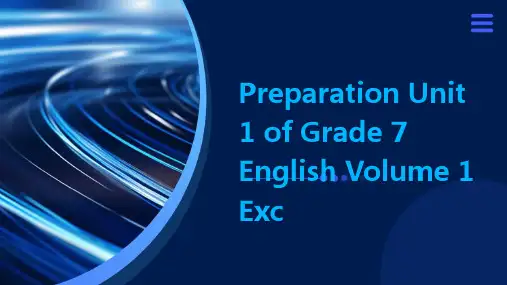
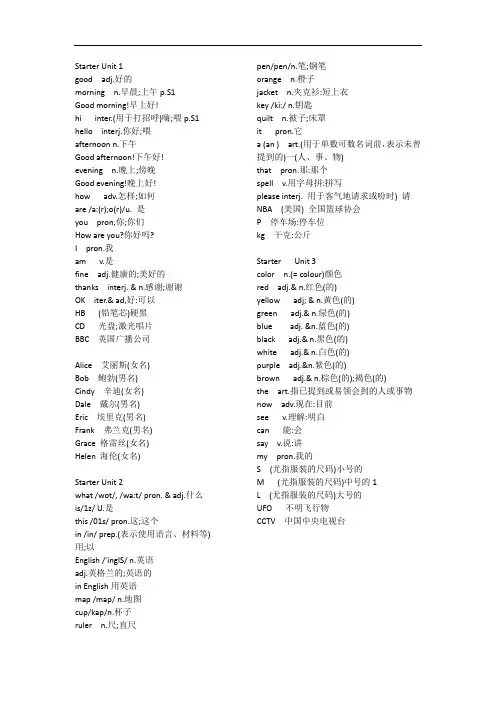
Starter Unit 1good adj.好的morning n.早晨;上午p.S1Good morning!早上好!hi inter.(用于打招呼)嗨;喂p.S1 hello interj.你好;喂afternoon n.下午Good afternoon!下午好!evening n.晚上;傍晚Good evening!晚上好!how adv.怎样;如何are /a:(r);o(r)/u. 是you pron,你;你们How are you?你好吗?I pron.我am v.是fine adj.健康的;美好的thanks interj. & n.感谢;谢谢OK iter.& ad,好:可以HB (铅笔芯)硬黑CD 光盘;激光唱片BBC 英国广播公司Alice 艾丽斯(女名)Bob 鲍勃(男名)Cindy 辛迪(女名)Dale 戴尔(男名)Eric 埃里克(男名)Frank 弗兰克(男名)Grace 格雷丝(女名)Helen 海伦(女名)Starter Unit 2what /wot/, /wa:t/ pron. & adj.什么is/1z/ U.是this /01s/ pron.这;这个in /in/ prep.(表示使用语言、材料等) 用;以English /'inglS/ n.英语adj.英格兰的;英语的in English用英语map /map/ n.地图cup/kap/n.杯子ruler n.尺;直尺pen/pen/n.笔;钢笔orange n.橙子jacket n.夹克衫:短上衣key /ki:/ n.钥匙quilt n.被子;床罩it pron.它a (an ) art.(用于单数可数名词前,表示未曾提到的)一(人、事、物)that pron.那:那个spell v.用字母拼:拼写please interj. 用于客气地请求或吩时) 请NBA (美国) 全国篮球协会P 停车场:停车位kg 干克:公斤Starter Unit 3color n.(= colour)颜色red adj.& n.红色(的)yellow adj; & n.黄色(的)green adj.& n.绿色(的)blue adj. &n.蓝色(的)black adj.& n.黑色(的)white adj.& n.白色(的)purple adj.&n.紫色(的)brown adj.& n.棕色(的);褐色(的)the art.指已提到或易领会到的人或事物now adv.现在:目前see v.理解:明白can 能:会say v.说:讲my pron.我的S (尤指服装的尺码)小号的M (尤指服装的尺码)中号的1L (尤指服装的尺码)大号的UFO 不明飞行物CCTV 中国中央电视台。
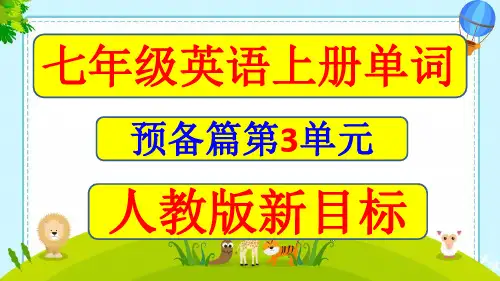
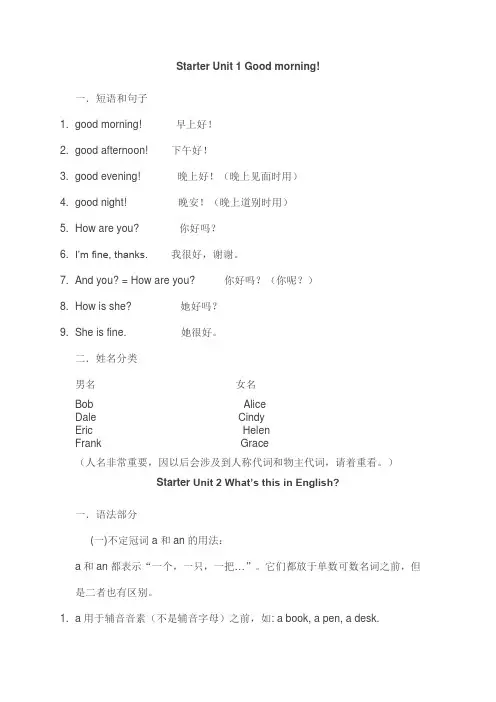
Starter Unit 1 Good morning!一.短语和句子1.good morning! 早上好!2.good afternoon! 下午好!3.good evening! 晚上好!(晚上见面时用)4.good night! 晚安!(晚上道别时用)5.How are you? 你好吗?6.I’m fine, thanks.我很好,谢谢。
7.And you? = How are you? 你好吗?(你呢?)8.How is she? 她好吗?9.She is fine. 她很好。
二.姓名分类男名女名Bob AliceDale CindyEric HelenFrank Grace(人名非常重要,因以后会涉及到人称代词和物主代词,请着重看。
)Starter Unit 2 What’s this in English?一.语法部分(一)不定冠词a和an的用法:a和an都表示“一个,一只,一把…”。
它们都放于单数可数名词之前,但是二者也有区别。
1. a 用于辅音音素(不是辅音字母)之前,如: a book, a pen, a desk.2.an用于元音音素(不一定是元音字母)之前,如:an egg, an apple, an icecream.元音字母包括:a e i o u特别强调:要会判断某个单字或字母的第一个音素是元音还是辅音,如下:pen发音为[ pen ],所以第一个音素为[p],可以看出是辅音。
horse发音为[ hɔːs ],所以第一个音素为[h],可以看出是辅音。
hour发音为['aʊə],所以第一个音素为[aʊ ],可以看出是元音。
university发音为[juːnɪ'vɜːsɪtɪ],所以第一个音素为[j ],可以看出是辅音。
umbrella发音为[ʌm'brelə],所以第一个音素为[ʌ ],可以看出是元音。
根据上例我们可以看出,并不是辅音字母就发辅音,元音字母就发元音,而是要看它在音标中的发音,所以同学们要特别注意。
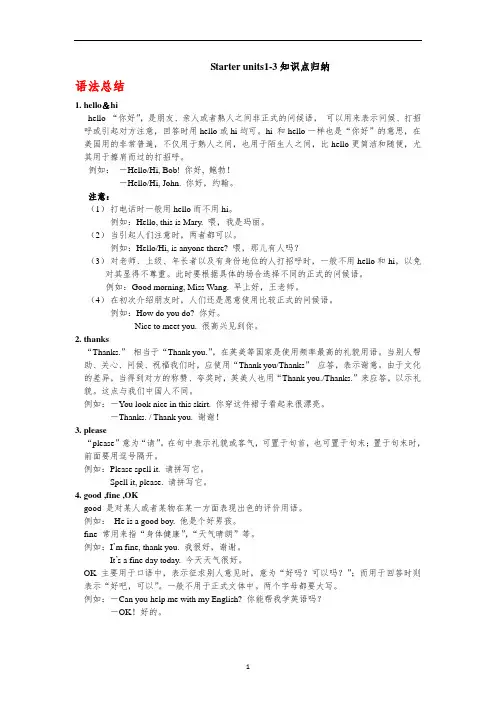
Starter units1-3知识点归纳语法总结1. hello&hihello “你好”,是朋友、亲人或者熟人之间非正式的问候语,可以用来表示问候、打招呼或引起对方注意,回答时用hello或hi均可。
hi 和hello一样也是“你好”的意思,在美国用的非常普遍,不仅用于熟人之间,也用于陌生人之间,比hello更简洁和随便,尤其用于擦肩而过的打招呼。
例如:-Hello/Hi, Bob! 你好, 鲍勃!-Hello/Hi, John. 你好,约翰。
注意:(1)打电话时一般用hello而不用hi。
例如:Hello, this is Mary. 喂,我是玛丽。
(2)当引起人们注意时,两者都可以。
例如:Hello/Hi, is anyone there? 喂,那儿有人吗?(3)对老师、上级、年长者以及有身份地位的人打招呼时,一般不用hello和hi,以免对其显得不尊重。
此时要根据具体的场合选择不同的正式的问候语。
例如:Good morning, Miss Wang. 早上好,王老师。
(4)在初次介绍朋友时,人们还是愿意使用比较正式的问候语。
例如:How do you do? 你好。
Nice to meet you. 很高兴见到你。
2. thanks“Thanks.”相当于“Thank you.”,在英美等国家是使用频率最高的礼貌用语。
当别人帮助、关心、问候、祝福我们时,应使用“Thank you/Thanks”应答,表示谢意。
由于文化的差异,当得到对方的称赞、夸奖时,英美人也用“Thank you./Thanks.”来应答,以示礼貌。
这点与我们中国人不同。
例如:-You look nice in this skirt. 你穿这件裙子看起来很漂亮。
-Thanks. / Thank you. 谢谢!3. please“please”意为“请”。
在句中表示礼貌或客气,可置于句首,也可置于句末;置于句末时,前面要用逗号隔开。
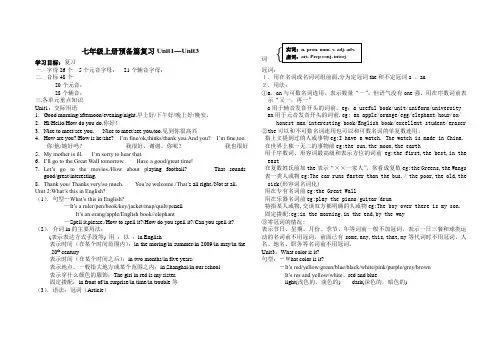
七年级上册预备篇复习Unit1—Unit3学习目标:复习一.字母26个5个元音字母:21个辅音字母:二.音标48个20个元音:28个辅音:三.各单元重点知识Unit1:交际用语1.Good morning/afternoon/evening/night.早上好/下午好/晚上好/晚安。
2.Hi/Hello/How do you do.你好!3.Nice to meet/see you. Nice to meet/see you,too.见到你很高兴4.How are you?/How is he/she? I’m fine/ok,thinks/thank you.And you? I’m fine,too.你/他/她好吗?我很好,谢谢。
你呢?我也很好5.My mother is ill. I’m sorry to hear that.6.I’ll go to the Great Wall tomorrow. Have a good/great time!7.Let’s go to the movies./How about pl aying football? That sounds good/great/interesting.8.Thank you/ Thanks very/so much. You’re welcome./That’s all right./Not at all. Unit 2:What’s this in English?(1).句型—What’s this in English?—It’s a ruler/pen/book/key/jacket/map/quilt/pe ncilIt’s an orang/apple/English book//elephant—Spell it,please./How to spell it?/How do you spell it?/Can you spell it? (2).介词in的主要用法:(表示表达方式手段等) 用;以:in English表示时间(在某个时间范围内):in the moring/in summer/in 2009/in may/in the 20th century表示时间(在某个时间之后):in two months/in five years/表示地点,一般指大地方或某个范围之内:in Shanghai/in our school表示穿什么颜色的服饰:The girl in red is my sister.固定搭配:in front of/in surprise/in time/in trouble等(3).语法:冠词(Article)词冠词:1.用在名词或名词词组前面,分为定冠词the和不定冠词a、an2.用法:①a、an与可数名词连用。
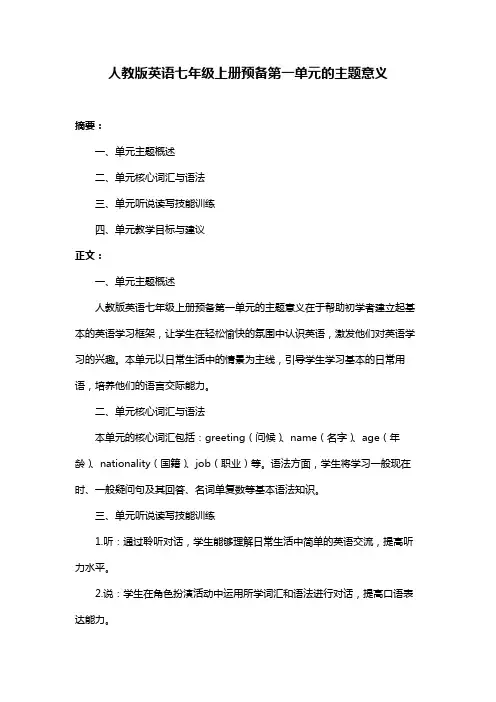
人教版英语七年级上册预备第一单元的主题意义摘要:一、单元主题概述二、单元核心词汇与语法三、单元听说读写技能训练四、单元教学目标与建议正文:一、单元主题概述人教版英语七年级上册预备第一单元的主题意义在于帮助初学者建立起基本的英语学习框架,让学生在轻松愉快的氛围中认识英语,激发他们对英语学习的兴趣。
本单元以日常生活中的情景为主线,引导学生学习基本的日常用语,培养他们的语言交际能力。
二、单元核心词汇与语法本单元的核心词汇包括:greeting(问候)、name(名字)、age(年龄)、nationality(国籍)、job(职业)等。
语法方面,学生将学习一般现在时、一般疑问句及其回答、名词单复数等基本语法知识。
三、单元听说读写技能训练1.听:通过聆听对话,学生能够理解日常生活中简单的英语交流,提高听力水平。
2.说:学生在角色扮演活动中运用所学词汇和语法进行对话,提高口语表达能力。
3.读:阅读课文,让学生在语境中巩固所学知识,培养阅读理解能力。
4.写:根据所给情景,学生可以运用所学词汇和语法知识进行写作练习,提高写作能力。
四、单元教学目标与建议1.教学目标:(1)学生能熟练掌握基本的日常英语问候及介绍自己和他人的词汇和语法;(2)学生能在实际情景中进行简单的英语交流;(3)学生能听懂、会说、读懂、会写关于个人基本信息的英语句子。
2.教学建议:(1)教师要以生动有趣的方式进行教学,激发学生的学习兴趣;(2)注重师生互动,鼓励学生大胆开口说英语;(3)结合实际生活情景,进行角色扮演等实践活动,提高学生的语言运用能力;(4)定期进行复习,巩固所学知识,确保学生掌握并能运用所学内容。
通过本单元的学习,学生能够建立起基本的英语学习体系,为后续的英语学习打下坚实基础。
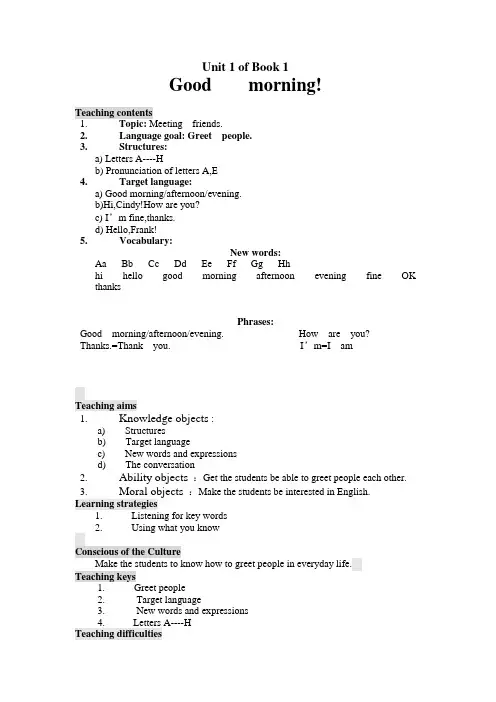
Unit 1 of Book 1Good morning!Teaching contents1.Topic: Meeting friends.nguage goal: Greet people.3.Structures:a) Letters A----Hb) Pronunciation of letters A,E4.Target language:a) Good morning/afternoon/evening.b)Hi,Cindy!How are you?c) I’m fine,thanks.d) Hello,Frank!5.Vocabulary:New words:Aa Bb Cc Dd Ee Ff Gg Hhhi hello good morning afternoon evening fine OK thanksPhrases:Good morning/afternoon/evening. How are you? Thanks.=Thank you. I’m=I amTeaching aims1.Knowledge objects :a)Structuresb)Target languagec)New words and expressionsd)The conversation2.Ability objects:Get the students be able to greet people each other.3.Moral objects:Make the students be interested in English. Learning strategies1.Listening for key wordsing what you knowConscious of the CultureMake the students to know how to greet people in everyday life.Teaching keys1.Greet people2.Target language3.New words and expressions4.Letters A----HTeaching difficulties1.Pronunciation of letters A,E2.How to greet peopleActivity planned1.Pairwork2.Groupwork3.Role play4.ListeningTeaching aids1.Cards2.tape-recorderTeaching time4 periods(section A + section B + Selfcheck)Teaching procedureStep 1:IntroductionBegin by greeting the class with a smile and good morning! Now,introduce the words “teacher”and “class”.by using gestures.Have the class repeat after you several times .Students Can answer as a whole group.As rows and as individuals.Repeat “I am your teacher and you are the class”several times.Now,introduce the class to the instructions:please sit down and please stand up by using actions and gestures.They can practice this several times.Step 2:Lead—inYou may leave the class again to introduce the usual Good morning routine.Say Good morning ,class.Help students respond with Good morning.Point to yourself and say I’m Miss /Mr.…Have them repeat.Explain the terms Miss and Mr.in Chinese.Repeat this a few times with rows and individuals or try a “back-chain” drill:Miss,Mr.…(Ss repeat)Morning,Miss/M r.…(Ss repeat)Good morning,Miss,Mr.…(Ss repeat)Step 3:PracticeSay:Stand up,please! (Ss stand up)Leave the classroom,return and say Good morning,class! Help the students respond with Good morning,Miss/Mr.…Say: Sit down,please.Now let’s start the lesson.Step 4:Presentation and activityNow point to yourself and say My name is Miss/Mr. (I)am your teacher.Find a student you know and say your name is….Then ask: What is your name? Help them respond with My name is… . When the student answers, respond with Hello…Nice to meet you! Repeat this activity several times,first with students you know and then with others.Help them to respond with Nice to meet you,too.Explain the Word “too’’ in Chinese.Step 5:PracticeGet the students to practice the dialogue in pairs.S1:Good morning.S2:Good morning.I’m ….What’s your name?Sl:My name is ….Nice to meet you!S2:Nice to meet you.too.Call out several pairs of students to give their performance.Praise their efforts as much as possible.Help the slower students with patience.Step 6:PresentationDo activity 1a:Look at the picture.Find the small letters for these big letters.First present letters a-h,and get the students to repeat these letters.Call the students to attention the letter C/si:/not/sei:/.H /eʧ/ not /eʧ/Step 7:Listening and writingGet the students to listen to the tape and finish the task list on the book.Make sure all the students know what they should do.Have the students watch the teacher writing the letters on the blackboard, then ask them to follow the teacher and write downStep 6:PresentationDo activity 1a:Look at the picture.Listen and repeat. Then present lettersA-H,and get the students to repeat these letters.Call the students to attention the letter C/si:/not/sei:/.H /eʧ/ not /eʧ/Step 7:Listening and writingGet the students to find the big letters for these small letters.Make sure all the students know what they should do.Ask a student to read the letters in 2c,then listen and number the letters you hear (1----8).Check the answer.Have the students watch the teacher writing the letters on the blackboard, then ask them to follow the teacher and write down these letters on their exercise—books.Let the students know the diffences between the big letters and the small letters.Step 8:Games timeLet the students do some letters games to enjoy your lesson,the following is the instruction.抢读字母游戏:教师将全班分成若干小组,然后逐个出示字母卡片,学生们举手抢答。
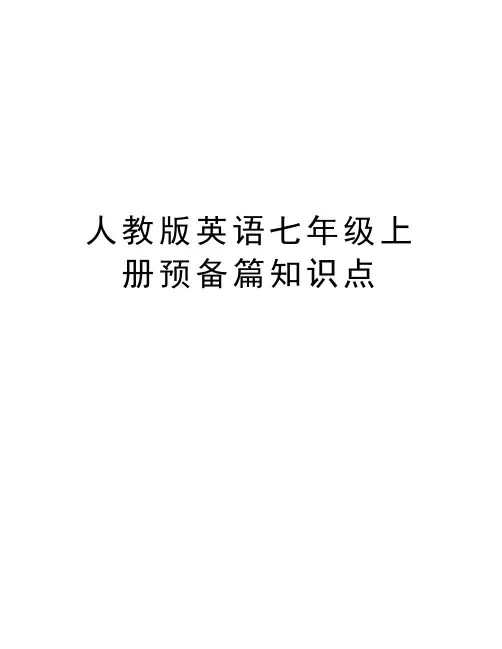
人教版英语七年级上册预备篇知识点Starter Unit 1 Good morning.1. Good morning/afternoon/evening. 早上(上午)/下午/晚上好。
答语相同。
在熟人或家人之间可省略good。
熟人之间的问候可加上称呼语,称呼语放在问候语之后且用逗号隔开。
如:Good morning , class!同学们,早上好!△Good night!晚安(晚间告别用语)2. Hello, Frank! 你好,弗兰克。
3 .A: How are you? 你(身体)好吗? B: (I’m)fine/Very well/I’m OK, Thank you./thanks. How are you? / And you?你呢? A: (I’m)fine/OK, too. 我也很好。
4. thanks = thank you 谢谢5. HB(铅笔芯)硬黑 CD光盘 BBC英国广播公司Starter Unit 2 What’s this in English?1. What’s this/that? 这/那是什么? It’s a/an + 单数物品(△不说This/That is...)1) What’s this / that? 这/那是什么? It’s an apple. 它是一个苹果.2) What’s this/that? 这/那是什么? It’s a ruler.它是一把直尺。
2. What’s this / that in English? 这/那用英语怎么说? It’s a/an + 单数物品(△不说This/Thatis...) What’s this in English? 这用英语怎么说?It’s a jacket. 它是一件夹克衫What’s that in English? 那用英语怎么说?It’s an orange. 它是一个橘子。
in + 语言:用某种语言 inChinese/English/Japanese用汉/英/日语英语中还可用What’s t he English for….?表达同样的含义。
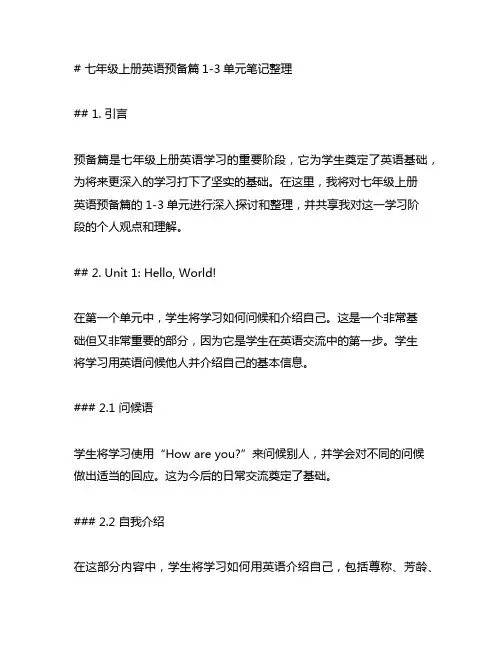
# 七年级上册英语预备篇1-3单元笔记整理## 1. 引言预备篇是七年级上册英语学习的重要阶段,它为学生奠定了英语基础,为将来更深入的学习打下了坚实的基础。
在这里,我将对七年级上册英语预备篇的1-3单元进行深入探讨和整理,并共享我对这一学习阶段的个人观点和理解。
## 2. Unit 1: Hello, World!在第一个单元中,学生将学习如何问候和介绍自己。
这是一个非常基础但又非常重要的部分,因为它是学生在英语交流中的第一步。
学生将学习用英语问候他人并介绍自己的基本信息。
### 2.1 问候语学生将学习使用“How are you?”来问候别人,并学会对不同的问候做出适当的回应。
这为今后的日常交流奠定了基础。
### 2.2 自我介绍在这部分内容中,学生将学习如何用英语介绍自己,包括尊称、芳龄、爱好等基本信息。
这部分内容对学生的口语表达能力有着很大的提升作用。
## 3. Unit 2: My School第二单元将介绍学校相关的词汇和日常用语。
学生将学习如何描述自己的学校以及学习用语言来表达对学校的喜爱。
### 3.1 学校相关词汇学生将学习如何用英语表达学校的不同部分,比如教室、图书馆、操场等。
这对学生在日常生活中描述学校环境有重要作用。
### 3.2 表达喜爱学生还将学会表达对学校的喜爱之情,比如“I love my school”、“My favorite place in the school is…”等表达方式。
## 4. Unit 3: My Friends第三单元主要介绍与朋友相关的词汇和表达方式。
学生将学习如何用英语描述自己的朋友并表达友谊之情。
### 4.1 朋友的描述学生将学会用英语描述朋友的外貌特征、性格特点和爱好等信息。
### 4.2 表达友情在这部分内容中,学生将学会如何表达对朋友的爱和友谊之情,学习像“I like my friend because…”、“My friend is very kind to me”等表达方式。
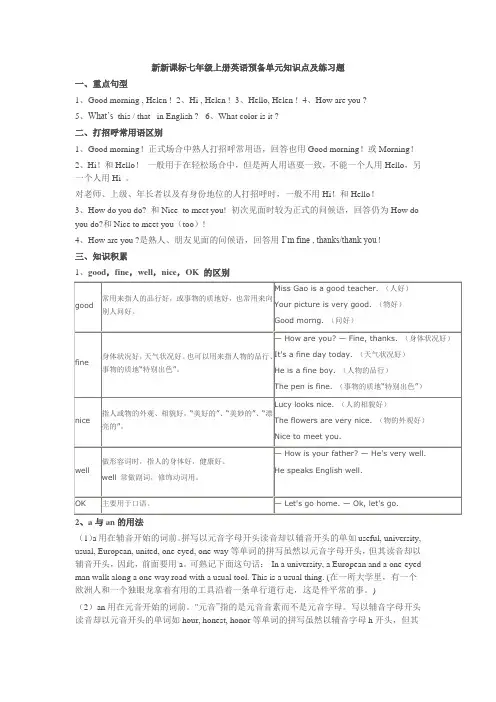
新新课标七年级上册英语预备单元知识点及练习题一、重点句型1、Good morning , Helen !2、Hi , Helen !3、Hello, Helen !4、How are you ?5、What’s this / that in English ?6、What color is it ?二、打招呼常用语区别1、Good morning!正式场合中熟人打招呼常用语,回答也用Good morning!或Morning!2、Hi!和Hello!一般用于在轻松场合中,但是两人用语要一致,不能一个人用Hello,另一个人用Hi 。
对老师、上级、年长者以及有身份地位的人打招呼时,一般不用Hi!和Hello!3、How do you do? 和Nice to meet you! 初次见面时较为正式的问候语,回答仍为How do you do?和Nice to meet you(too)!4、How are you ?是熟人、朋友见面的问候语,回答用I’m fine , thanks/thank you!三、知识积累1、good,fine,well,nice,OK 的区别读音却以元音开头,因此,前面要用an。
可熟记下面这句话:An hour ago, an honest man accepted an honorable task. (一小时前,一位诚实的人接受了一项光荣的任务。
)(3)英文字母前用a还是用an的问题。
在26个英文字母中,a, e, i, o, f, h, l, m, n, r, s, x等12个字母的读音是以元音开头的,要用an,其余字母则是以辅音开头的,用a。
3、介词in的用法(1)What’s this in English? A.The one in blue.(2)Is this a book? B.He’s my father.(3)Who’s that man? C.It’s orange.(4)What color is that orange? D.Yes.it is.(5)How are you? E.It’s a map.(6)Which boy is your brother? F.No, it’s yellow.(7)What is this? G.It’s an orange.(8)Is that jacket black? H.Fine,thank you.一.单项选择(把正确的选择项填到题前的括号内)(10分)()1.— Good morning.---- ________.A. Hello, GoodB. Good morningC. Good afternoonD. OK ( ) 2. ---- How are you ?----- ________________.A. Thank youB. Sit down, please.C. I’m fineD. Goodmorning( ) 3. What _______ this ?A.amB. areC. isD. be( ) 4. ----- What’s th is in English ?------ It’s __________ .A.an orangeB. a orangeC. orangeD. the orange( ) 5. ---- Spell it , please!----________ .A.ThankB. P—e –n, penC. It’s penD. OK( ) 6. ----____________?---- It’s a ruler.A. What’s this in EnglishB. How are youC. Good afternoonD. OK( ) 7. What color _______ it?A.isB. areC. amD. be( ) 8. -What’s this?-________ a key.A. He’sB. This’sC. It’sD. That’s( ) 9. --- What color is the ruler?----- _____________.A. It’s a rulerB. It’s whiteC. It’ a whiteD. it’s white( ) 10. ---- Please sit down.----- _____________.A.HelloB. Thank youC. Sit downD. I’m fine二.根据中文提示选出正确的答语, 并将答案编号写在题号前的括号内(20分)1. 早上你遇见老师、同学或朋友时,应该说:__________________________A. How are you?B. Good morning!C. Thank you.2. 如果你的朋友向你问好,他说:How are you?你应回答:__________________________A. How are you?B. Fine, thank you.C. I'm fine, too.3. 当你在路上遇见你的老朋友,他说:Hello!你应该说:__________________________A. Good!B. How are you?C. Hello!4. 当你想知道对方的名字时,你应问:__________________________A. What's this?B. What's your name?C. How are you?5. 当别人夸奖你的衣服漂亮时,你应说:__________________________A. Please!B. Thank you.C. No.6. 当你的老师向你介绍一位新同学时,你应对你的新同学说:________________________A. How are you?B. Nice to meet you.C. Thanks.7. 当你进了Mr. Du的办公室,他说:Sit down, please! 你应回答:__________ __________A. Yes, I sit down.B. Thanks.C. Please!8. 你手里拿着一张字母卡片问别人时,应说:__________________________A. What's this?B. What's your name?C. How are you?9. 当你向别人自我介绍时,应说:_____________A. I am Song Xiu.B. Thank you.C. Sit down, please!10. 当你参加朋友的party时, 见到你的老同学、老朋友,他说:Hi! 你应说:_________A. Hi!B. Good!C. Thank you.三.写出下列字母所代表的意思按顺序默写26个大小写字母,注意格式:(13%)四.完成对话(把下列的对话补充完整)(12分)A: Good afternoon, Dale!B: _____________ ___, Frank?A: How are you !B: I’m __________, thanks, ____________ __?A: I’m OK.B: ________________________ ___?A: It’s a jacket.B: Speel it ,please.A:________________.B: What color is it?A:It’s _____________B: Thanks.五.根据所给汉语提示补全句子。
七年级英语上册预备篇Units1-3教案主备人:Jiao ChaonanStarter Unit 1 Good morning教案主备人:焦超男:审核人:李君萍使用人:时间:Period one( sectionA1a-4c)【学习目标】:1、熟悉掌握本节的新单词。
2、学会书写八个大小写字母A---H.3、会运用基本的交际用语.【学习重点】:1、记忆并正确书写A—H等八个字母。
2、使学生学会用基本交际用语打招呼.【学习过程】一、自主学习(教师寄语:Knowledge is power.)学习任务一: 1. 熟悉掌握词汇。
早晨______ hello______ 晚上好________ afternoon_____BBC_______ 早上好_______好的_______下午好______________2. 认真观察第一页的图画,小组讨论具体含义。
3.听录音,跟读。
两人一组练习互相问候,小组展示。
学习任务二: 1.看2a完成2b,并独立完2d及3.2.合上书,独立在下面正确书写A到H的大小写字母。
小组内检查3.听录音完成2c.学习任务三: 1.听录音, 完成4a并给4b的图片编号.2.两人一组练习4b的对话,小组竞赛, 展示对话交际。
二、合作探究(教师寄语:Many hands make light work. )小组合作讨论在英语中,当人们见面问上午,下午,晚上好的问候语的时候,对方应该怎样回答呢?三、系统小结(教师寄语:No man can do two things at once.)1.Words:_______________________________________________________________.2.Sentences:_____________________________________________________________.四、当堂检测(一)、按要求完成。
英语七年级上册预备单元单词Starter Unit 1 Good morning!1. good [gud] adj. 好的。
2. morning ['mɔ:niŋ] n. 早晨;上午。
3. Good morning! 早上好!4. hi [hai] int. (用于打招呼)嗨;喂。
5. hello [hə'ləu] int. 你好;喂。
6. afternoon [,ɑ:ftə'nu:n] n. 下午。
7. Good afternoon! 下午好!8. evening ['i:vniŋ] n. 晚上;傍晚。
9. Good evening! 晚上好!10. how [hau] adv. 怎样;如何。
11. are [ɑ:] v. 是。
12. you [ju:] pron. 你;你们。
13. How are you? 你好吗?14. I [ai] pron. 我。
15. am [æm] v. 是。
16. fine [fain] adj. 健康的;美好的。
17. thanks [θæŋks] int. & n. 感谢;谢谢。
18. OK [əu'kei] int. & adj. 好;可以。
Starter Unit 2 What's this in English?1. what [wɔt] pron. & adj. 什么?2. is [iz] v. 是。
3. this [ðis] pron. 这;这个。
4. in [in] prep. (表示使用语言、材料等)用;以。
5. English ['iŋgliʃ] n. 英语adj. 英格兰的;英语的。
6. in English 用英语。
7. map [mæp] n. 地图。
8. cup [kʌp] n. 杯子。
9. ruler ['ru:lə] n. 尺;直尺。
Unit 1 of Book 1Good morning!Teaching contents1.Topic: Meeting friends.nguage goal: Greet people.3.Structures:a) Letters A----Hb) Pronunciation of letters A,E4.Target language:a) Good morning/afternoon/evening.b)Hi,Cindy!How are you?c) I’m fine,thanks.d) Hello,Frank!5.Vocabulary:New words:Aa Bb Cc Dd Ee Ff Gg Hhhi hello good morning afternoon evening fine OK thanksPhrases:Good morning/afternoon/evening. How are you? Thanks.=Thank you. I’m=I amTeaching aims1.Knowledge objects :a)Structuresb)Target languagec)New words and expressionsd)The conversation2.Ability objects:Get the students be able to greet peopleeach other.3.Moral objects:Make the students be interested in English.Learning strategies1.Listening for key wordsing what you knowConscious of the CultureMake the students to know how to greet people in everyday life. Teaching keys1.Greet people2.Target language3.New words and expressions4. Letters A----HTeaching difficulties1.Pronunciation of letters A,E2.How to greet peopleActivity planned1.Pairwork2.Groupwork3.Role play4.ListeningTeaching aids1.Cards2.tape-recorderTeaching time4 periods(section A + section B + Selfcheck)Step 6:PresentationDo activity 1a:Look at the picture.Listen and repeat. Then present lettersA-H,and get the students to repeat these letters.Call the students to attention the letterC/si:/not/sei:/.H /eʧ/ not /eʧ/Step 7:Listening and writingGet the students to find the big letters for these small letters.Make sure all the students know what they should do.Ask a student to read the letters in 2c,then listen and number the letters you hear (1----8).Check the answer.Have the students watch the teacher writing the letters on the blackboard, then ask them to follow the teacher and write down these letters on their exercise —books.Let the students know the diffences between the big letters and the small letters.Step 8:Games timeLet the students do some letters games to enjoy your lesson,the following is the instruction.抢读字母游戏:教师将全班分成若干小组,然后逐个出示字母卡片,学生们举手抢答。
七年级上册预备一单元英语笔记一、 Introduction to English Study1. Learning a new language can be both exciting and challenging.2. English is a widely spoken language and is often considered the international language of business, travel, and diplomacy.3. In this unit, we will lay the foundation for learning English by focusing on basic vocabulary, grammar, andmunication skills.二、 Basic Vocabulary1. Start with learningmon greetings and introductions such as "hello, hi, good morning, good afternoon, good evening, etc."2. Expand vocabulary by learning numbers, days of the week, months, and personal pronouns.3. Practice using these words and phrases in everyday conversations and scenarios.三、 Grammar1. Begin with the basics of English grammar including subject-verb agreement, articles, plurals, and tenses.2. Understand the structure of simple sentences and how to form questions and negatives.3. Practice using grammar rules in writing and speaking exercises.四、 Communication Skills1. Focus on listening and speaking exercises to improve pronunciation and fluency.2. Practice having simple conversations with classmates and teachers in English.3. Work on building confidence in speaking and expressing ideas in English.五、 Resources for Studying English1. In addition to classroom materials, use online resources, textbooks, and language learning apps to supplement your learning.2. Read English books, watch English movies or TV shows, and listen to English podcasts to expose yourself to the language in various contexts.3. Find a language exchange partner or join an English-speaking club to practice speaking and listening skills.六、 Study Tips1. Set aside dedicated time each day to study English, even if itis just for a few minutes.2. Create a study schedule and stick to it to ensure consistent progress.3. Review and practice regularly to reinforce what you have learned.七、 Conclusion1. Learning a new language requires dedication and practice, but the rewards are well worth the effort.2. By focusing on building a strong foundation in vocabulary, grammar, andmunication skills, you will be well-equipped to continue your English studies with confidence.3. Stay motivated and keep an open mind as you embark on this exciting journey of learning English.。